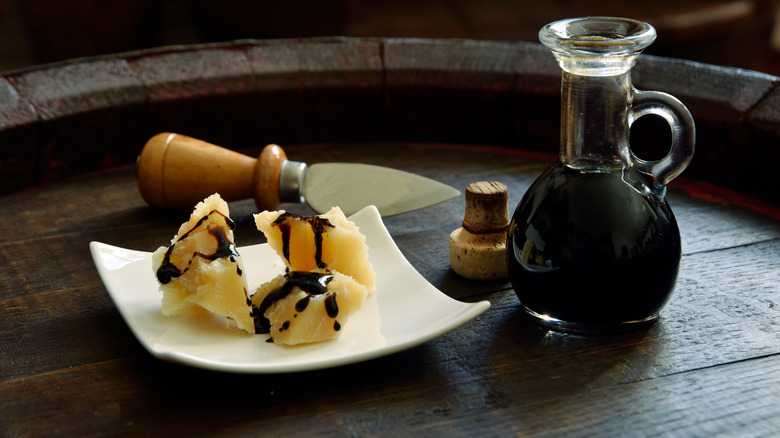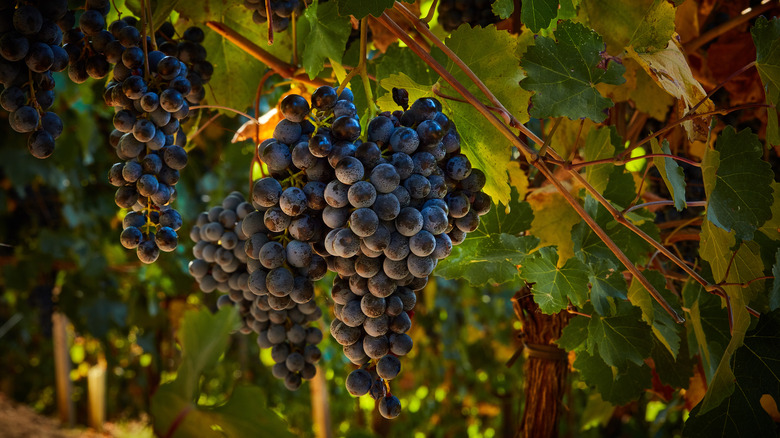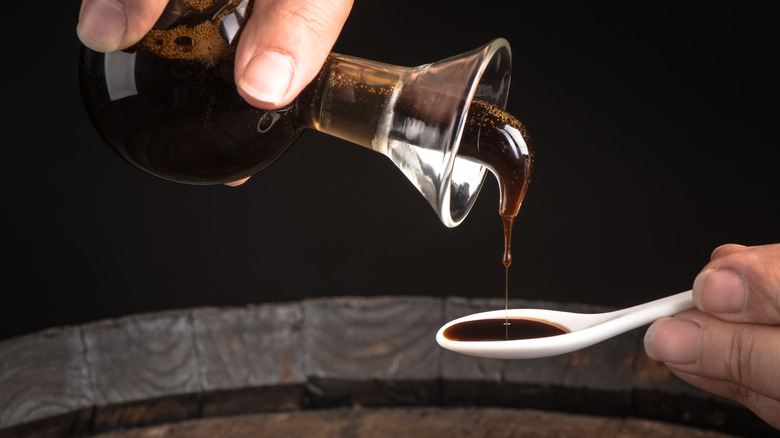What Makes Balsamic Vinegar So Different From Other Vinegars?
CORRECTION 11/18/22: A previous version of this article stated IGP-labeled balsamic vinegar is made with wine vinegar, it is also required to contain grape must to bear the IGP label.
Balsamic vinegar has been around for at least a millennium, yet it's only been on American shelves since the '70s. According to Serious Eats, balsamic spent most of its history lingering in relative obscurity. It existed in a very limited geographic area, which corresponds to the modern Italian provinces of Reggio Emilia and Modena. It has long been prized by the region's residents, exemplified by the case of the Holy Roman Emperor Henry III, who visited Reggio Emilia in 1046. What did the locals choose as a gift? A bottle of vinegar.
Though you see it on shelves all around the country now, balsamic was unknown in the U.S. until Chuck Williams, founder of the culinary store Williams-Sonoma, had some imported to the States in 1978 (via The New York Times). Now it's all over the culinary world, often used in expected ways such as making vinaigrette dressing, though it's far more versatile than just that. Balsamic vinegar shows up in all kinds of unexpected places, like cocktails and braised chicken, and seems to be constantly growing in popularity. So, what makes balsamic stand out so much from other vinegars?
No other vinegar is made this way
What really distinguishes traditional balsamic from other vinegars is its one-of-a-kind production process. It's so challenging to make that Boston.com, an online extension of the Boston Globe, ran an article telling any readers who wanted to make their own balsamic at home not to bother. You see, every other type of vinegar is made by fermenting wine until the alcohol converts into acetic acid. Red wine vinegar and white wine vinegar start as regular red and white wine, which you yourself could readily access and turn into vinegar if you wanted. Balsamic, on the other hand, requires very specific ingredients, specialized equipment, and more than a decade of waiting.
Whereas every other vinegar starts as wine, balsamic is made from the grapes themselves. According to Serious Eats, traditional balsamic specifically requires sweet, pale grapes, like the Lambrusco or Trebbiano varieties. To make vinegar, producers press grapes into must, which is a pulpy blend of grape flesh, juice, seeds, peels, and stems. No part of the grape goes to waste. The must is filtered and then briefly cooked to reduce before the fermentation process begins. MasterClass notes that traditional balsamic vinegar must be aged for a minimum of 12 years and up to 25; Older bottles are often labeled "extravecchio," or extra-aged.
You've probably never tried true balsamic vinegar
Now we've got some disappointing news for you: you've likely never had balsamic vinegar made in the way we just described unless you've dropped a few hundred bucks on a single bottle. That's right, making balsamic vinegar the traditional way is so laborious that they're bound to have a high asking price. For example, Salon reports that a single bottle of Cavalli Gold Label Balsamic will set you back $275. Of course, you'll find much cheaper bottles of balsamic at the grocery store, but those aren't really balsamic.
MasterClass explains that traditional balsamic is either labeled as "Aceto Balsamico Tradizionale di Modena DOP" or "Aceto Balsamico Tradizionale di Reggio Emilia DOP." In English, those terms mean traditional balsamic vinegar from Modena or Reggio Emilia, the last words referring to its place of origin. You've likely seen labels saying 'Balsamic Vinegar of Modena IGP,' and it's important to note that this is different from authentic Aceto Balsamico Tradizionale di Modena DOP. Per Serious Eats, DOP and IGP (sometimes translated to PDO and PGI in English) are EU certifications, wherein the DOP label designates only those products made in traditional fashion from local ingredients in their native region, and IGP indicates products from that region that may have been made from non-local ingredients. Balsamic with the IGP label is made from wine vinegar and grape must. It only needs to be aged for two months, but you can enhance its flavor and texture with this easy reduction.


